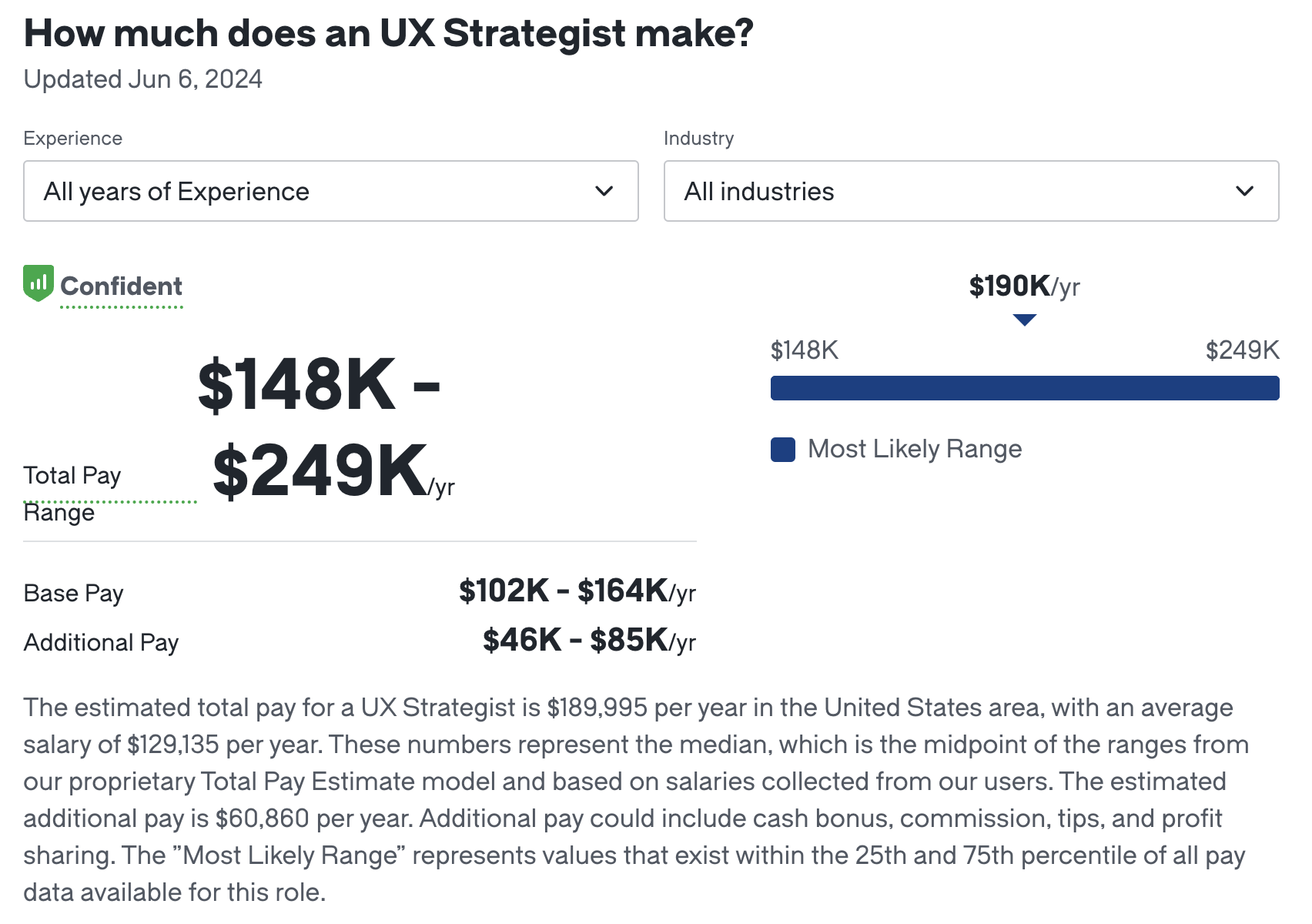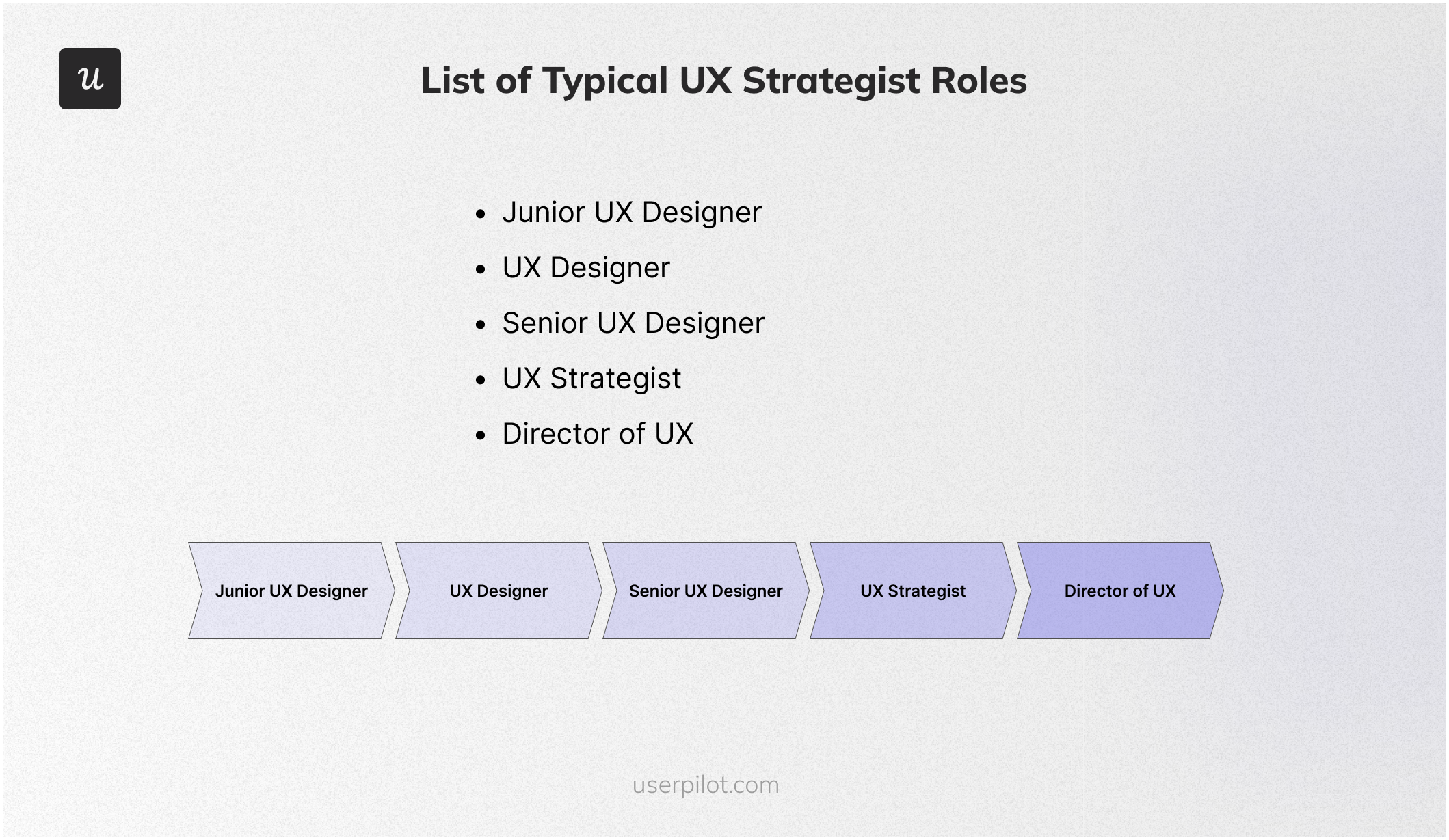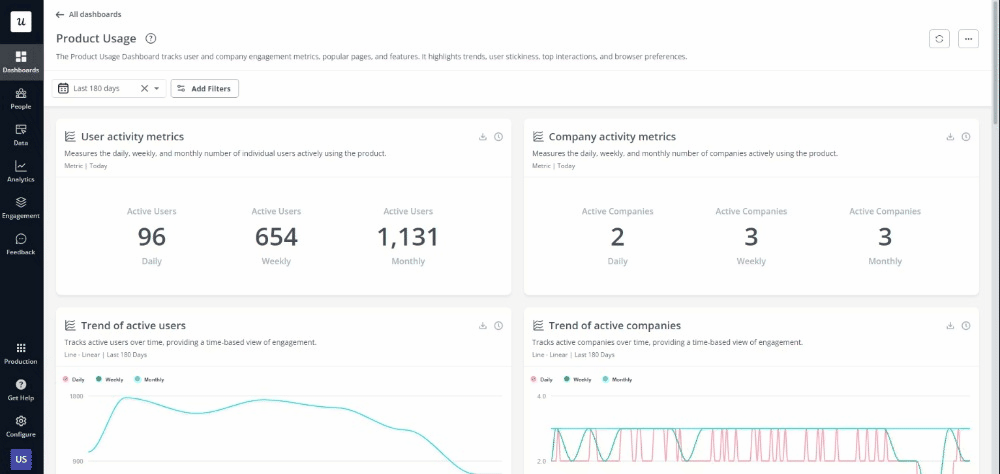
Starting a career as a UX strategist requires understanding the key steps, skills, and experiences needed for success.
In this article, we will outline the typical journey for UX strategists, covering educational requirements, entry-level positions, potential advancements, and long-term opportunities.
Without further ado, let’s get into it!
Try Userpilot Now
See Why 1,000+ Teams Choose Userpilot

TL;DR
- In SaaS, UX strategists help optimize user onboarding, increase product adoption, and ensure seamless feature integration, working closely with product managers and developers to align the user experience with strategic objectives.
- According to Glassdoor, the estimated total pay for a UX strategist is $189,995 per year in the United States. This includes an average base pay of $129,135 per year and additional pay of $60,860 per year, which may consist of cash bonuses, commissions, tips, and profit sharing. The total pay range for this role is $148,000 to $249,000 per year.
- A UX strategist’s career path involves progressing through various roles that build on experience, skills, and strategic capabilities. Here’s their typical progression path:
- Junior UX designer
- UX designer
- Senior UX designer
- UX strategist
- Director of UX
- A UX strategist needs a suite of tools to efficiently manage projects, understand user behavior, design intuitive interfaces, and ensure overall customer satisfaction. Here are several essential tools that every UX strategist should consider integrating into their workflow (keep reading for more):
- Best tool for user engagement and feedback – Userpilot
- Best tool for project management – Monday.com
- Best tool for product management – Jira Software
- Best tool for customer support – Zendesk
- Best tool for customer success management – ChurnZero
- Best tool for UX/UI design – Figma
- Looking into tools for UX strategists? Userpilot is an all-in-one product platform with engagement features and powerful analytics capabilities. Book a demo to see it in action!
What is a UX strategist?
A UX strategist blends user experience design with business goals to create cohesive digital products.
In SaaS, they optimize user onboarding, increase product adoption, and ensure seamless feature integration, working closely with product managers and developers to align the user experience with strategic objectives.
What does a UX strategist do?
A UX strategist develops and implements strategies to improve the overall user experience of digital products. They conduct user research, create user personas, and map out user journeys to identify pain points and opportunities for enhancement.
They also focus on optimizing user onboarding processes, increasing product adoption, and ensuring the seamless integration of new features.
UX strategist’s main responsibilities
A UX strategist plays a crucial role in aligning user experience design with business goals to create effective and engaging digital products, especially in the SaaS industry.
- User research: Conduct comprehensive user research to gather insights into user behaviors, needs, and pain points.
- Persona development: Create detailed user personas to guide design decisions and ensure they align with user needs.
- User journey mapping: Develop and map out user journeys to identify key touchpoints and areas for improvement.
- Strategy development: Formulate and implement UX strategies that enhance user onboarding, increase product adoption, and ensure seamless feature integration.
- Collaboration: Work closely with product managers, developers, and other stakeholders to ensure design decisions support business objectives.
- Usability testing: Plan and conduct usability testing to validate design concepts and gather feedback for continuous improvement.
- Analytics and reporting: Utilize analytics to measure the effectiveness of UX strategies and report findings to stakeholders.
- Continuous improvement: Stay updated with the latest UX trends, tools, and methodologies to continuously enhance the user experience.
- Competitive analysis: Analyze competitors’ products to identify best practices and opportunities for differentiation.
- Documentation: Maintain detailed documentation of research findings, design decisions, and strategy implementations for future reference.
UX strategist salary
According to Glassdoor, the estimated total pay for a UX strategist is $189,995 per year in the United States. This includes an average base pay of $129,135 per year and additional pay of $60,860 per year, which may consist of cash bonuses, commissions, tips, and profit sharing. The total pay range for this role is $148,000 to $249,000 per year.
One of the biggest factors influencing your salary is your experience level. Here’s how experience can impact your UX strategist salary, according to Glassdoor:
- 0 to 1 year: $96,000 – $174,000 per year
- 1 to 3 years: $112,000 – $193,000 per year
- 4 to 6 years: $139,000 – $229,000 per year
- 7 to 9 years: $156,000 – $253,000 per year
- 10 to 14 years: $172,000 – $277,000 per year
- 15+ years: $191,000 – $312,000 per year
Industries where UX strategists tend to earn the highest salaries include:
- Arts, Entertainment, and Recreation: $162,000 – $258,000 per year
- Pharmaceutical and Biotechnology: $163,000 – $258,000 per year
- Education: $153,000 – $241,000 per year
- Financial Services: $180,000 – $267,000 per year
- Information Technology: $176,000 – $267,000 per year
Locations with high salaries for UX strategists include:
- San Francisco: $175,000 – $281,000 per year
- New York: $164,000 – $276,000 per year
- Boston: $158,000 – $264,000 per year
- Chicago: $148,000 – $249,000 per year
These figures highlight the significant impact of experience, industry, and location on the earning potential of UX strategists.

UX strategist career path
A UX strategist’s career path involves progressing through various roles that build on experience, skills, and strategic capabilities.

Junior UX designer
As a junior UX designer, you begin by assisting senior designers with tasks such as user research, creating wireframes, and supporting the development of design projects.
This role focuses on gaining practical experience, learning design tools, and building a foundational portfolio. It provides essential exposure to understanding user needs, design principles, and the collaborative nature of UX work.
UX designer
Progressing to a UX designer, you take on more responsibility by leading smaller projects and collaborating closely with cross-functional teams, including product managers and developers.
Your duties expand to include conducting usability testing, refining user interfaces based on feedback, and ensuring that design solutions are both user-friendly and aligned with business goals.
Senior UX designer
With several years of experience, you advance to a senior UX designer. In this position, you lead major design projects, mentor junior designers, and play a key role in developing design strategies.
Your responsibilities include overseeing the creation of detailed design specifications, ensuring consistency across all user interfaces, and driving the overall user experience vision.
UX strategist
As a UX strategist, you focus on aligning user experience with business objectives. You conduct in-depth user research, create user personas, and map user journeys to identify areas for improvement.
You develop and implement strategic UX plans that enhance user onboarding, increase product adoption, and ensure seamless feature integration. Collaboration with product managers, developers, and other stakeholders is crucial to ensure that design solutions support the company’s strategic goals.
Director of UX
As the Director of UX, you lead multiple UX projects and oversee the strategic direction of user experience across the organization. Your role involves mentoring other UX professionals, influencing the broader company strategy with UX insights, and ensuring that all products and services deliver exceptional user experiences.
How to become a UX strategist
To become a UX strategist, start with a bachelor’s degree in UX design, human-computer interaction, psychology, or a related field. Gain practical experience through internships or entry-level UX roles to build a strong portfolio.
Enhance your credentials with certifications in UX design, and continuously update your knowledge through workshops, webinars, and online courses. Developing strategic thinking and project management skills is also essential for advancing in this career.
Best resources for UX strategists
To excel as a UX strategist, it’s crucial to continually learn and stay updated with the latest trends, techniques, and insights. Here are some of the best books, webinars, podcasts, blogs, and certifications that can help you enhance your UX strategy skills.
Best books for UX strategists
Books provide in-depth knowledge and foundational principles essential for UX strategists.
- The Design of Everyday Things by Don Norman: A classic that delves into the principles of user-centered design and the psychology behind effective usability.
- Don’t Make Me Think by Steve Krug: A practical guide to web usability and intuitive design, focusing on making websites easy to use.
- Lean UX by Jeff Gothelf and Josh Seiden: Combines lean startup principles with user experience design, promoting collaboration and iterative processes.
- About Face: The Essentials of Interaction Design by Alan Cooper: Comprehensive coverage of interaction design principles and techniques, essential for creating engaging interfaces.
- Hooked: How to Build Habit-Forming Products by Nir Eyal: Offers insights into creating products that users can’t put down, focusing on behavior-driven design.
Best webinars for UX strategists
Webinars offer the opportunity to learn from industry experts and stay current with UX trends.
- Userpilot Webinars: Regular sessions on user onboarding, product adoption, and UX best practices, led by industry experts.
- NN/g (Nielsen Norman Group) Webinars: Expert-led webinars on various UX topics and usability research findings, providing actionable insights.
- UX Design Institute Webinars: Webinars covering a range of UX design and strategy topics, helping you stay updated with the latest trends.
- Interaction Design Foundation (IDF) Webinars: Insights from industry experts on UX research, design, and strategy, with practical applications.
- Adobe XD Webinars: Training and insights on using Adobe XD for UX design, offering tips and best practices from professionals.
Best blogs for UX strategists
Blogs provide regular updates, insights, and tips to keep your UX strategy sharp.
- Userpilot Blog: Articles on user onboarding, product adoption, and UX best practices, with actionable tips.
- NN/g (Nielsen Norman Group) Blog: Research-based articles on usability and user experience, offering deep insights.
- Smashing Magazine: Comprehensive articles on UX design, coding, and content strategy, catering to various skill levels.
- UX Planet: A community-driven blog with articles on various UX topics, providing diverse viewpoints and tips.
- UX Collective: Curated stories on UX, product design, and usability, featuring contributions from industry experts.
Best podcasts for UX strategists
Podcasts are a great way to stay informed and inspired on the go.
- Userpilot Product Heroes: Discussions on user onboarding, engagement, and UX best practices, featuring industry leaders.
- UI Breakfast: Interviews with industry experts about UI/UX design, product strategy, and business, providing valuable insights.
- The UX Podcast: Covers UX design, research, strategy, and everything in between, offering diverse perspectives.
- What is Wrong with UX: A humorous take on UX design challenges and solutions, making learning fun.
- Design Better Podcast: Insights from top designers on improving design processes and outcomes, focusing on practical advice.
Best tools for UX strategists
A UX strategist needs a suite of tools to efficiently manage projects, understand user behavior, design intuitive interfaces, and ensure overall customer satisfaction. Here are 10 essential tools that every UX strategist should consider integrating into their workflow:
- Best tool for user engagement and feedback – Userpilot: Userpilot helps you create personalized in-app experiences without coding, making it easier to onboard users, increase product adoption, and collect user feedback.
- Best tool for project management – Monday.com: Monday.com provides an intuitive interface for managing projects, tasks, and team collaboration, helping UX strategists keep everything on track and visible.
- Best tool for product management – Jira Software: Jira Software is ideal for agile project management, offering powerful features for tracking issues, managing tasks, and optimizing product development workflows.
- Best tool for customer support – Zendesk: Zendesk delivers robust customer support features, allowing you to manage tickets, track customer interactions, and improve overall user satisfaction with ease.
- Best tool for customer success management – ChurnZero: ChurnZero helps you understand how customers use your product, track their health, and proactively engage with them to reduce churn and increase retention.
- Best tool for UX/UI design – Figma: Figma is a collaborative interface design tool that allows multiple team members to work on a design simultaneously, streamlining the design process and improving productivity.
- Best tool for data analytics – Tableau: Tableau offers powerful data visualization capabilities, enabling UX strategists to analyze user data, identify trends, and make data-driven decisions.
- Best tool for customer experience management – HubSpot Service Hub: HubSpot Service Hub integrates seamlessly with other HubSpot tools, providing a comprehensive solution for managing customer inquiries, feedback, and support tickets.
- Best tool for collaborative documentation – Confluence: Confluence, by Atlassian, allows teams to create, share, and collaborate on project documentation, making it easier to maintain a single source of truth.
- Best tool for visual project tracking – Trello: Trello uses a card-based system to help UX strategists visualize project tasks, track progress, and collaborate with team members in a flexible and intuitive way.
Conclusion
We hope our article has given you a good overview of the career path for UX strategists.
Whether you’re just starting out or looking to advance, the key is to stay curious, keep learning, and remain open to new opportunities along the way.
Looking into tools for UX strategists? Userpilot is an all-in-one product platform with engagement features and powerful analytics capabilities. Book a demo to see it in action!








